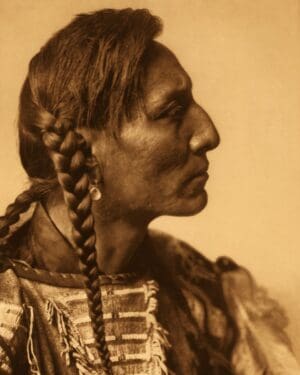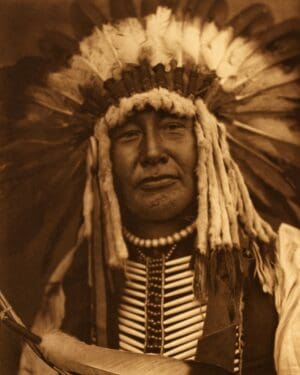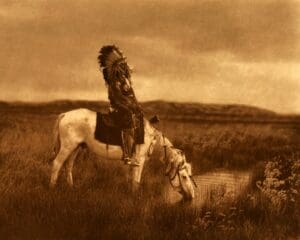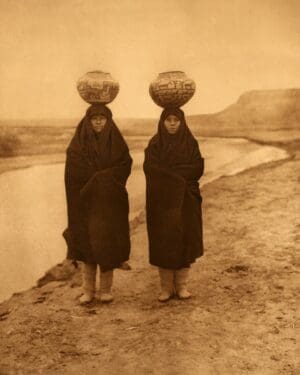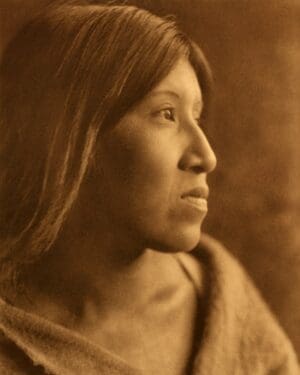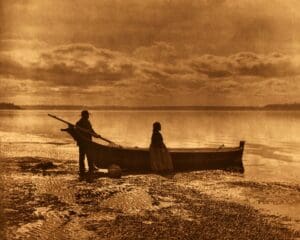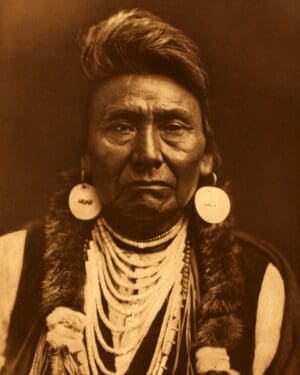Mandan Native Americans
Mandan Indian Photos by Edward S. Curtis
Tribal Summary
Dress
Mandan Indian men wore the usual shirt of deerskin or mountain-sheep skin ornamented with porcupine-quills, and leggings and moccasins of buffalo-skin from an old ti pi-covering. For gala or ceremonial occasions leggings were of deerskin, fringed and embroidered. Loin-cloths also were of deerskin, but their use was not general as late as the beginning of the eighteenth century. La Verendrye (1738) says that the men were naked, save for a carelessly worn robe, while the women wore aprons a handbreath wide and a foot long, but sometimes they were clothed in gowns of deerskin. For winter they had fur gloves and caps, and moccasins with the hairy side in. The hair was parted from crown to temples, the forelock thus created being cut to hang to the level of the nose, and curled upward by being rolled on a heated stick. At the sides the hair was cut shoulder-length, and in the back twisted into several strands, which were gummed at intervals with a bit of mixed clay and glue, or tied with deerskin cords. Perfumes of grasses and herbs were rubbed on the face, and strings of dentalium shells dangled from the hair at the temples and frequently from the ears. Face paints were of red ochre, yellow ochre, white clay, white clay made pink with grape juice, and for certain dances charcoal.
The women’s dress consisted of two mountain-sheep skins sewn together down the sides and over the shoulders, one of the stubby tails hanging down from the breast, the other from the back. The hair was left on the tails, and at other places as a trimming along the under and upper sides of the sleeves and around the collar, and the bottom was fringed and hung with small pieces of sheep-hoof. No embroidery ornamented the garment, which reached the ankles. Sleeves extended nearly to the wrists, and the upper part between the lines of fur was painted. Openings were left at the armpits. Moccasins reaching to the ankle were supplemented with deerskin leggings extending above the knee and fringed near the bottom. Married women painted stripes on their leggings to indicate their husbands’ honors in war. Women parted the hair in the middle from forehead to nape, and it hung in two braids in front of the shoulders, the ends being wrapped with deerskin cords. From each swung a string of two cylindrical bones. Women used paint and perfume even more than the men. Tattooing, done by means of porcupine-quills and charcoal, was frequently seen on the right breast and arm of the men and the lower part of the face of women. This was always done by certain men to the accompaniment of songs, the words of which were Assiniboin.
Dwelling
The Mandan built an earth-covered lodge exactly like that of the Hidatsa.
Food
Staple foods were corn, beans, squash, sunflower seeds, and meat, principally that of the buffalo. All the larger animals and many of the smaller ones were used when obtainable. Choke-cherries, buffalo-berries, service-berries, turnips (pomme blanche), and wild tubers were gathered in quantity.
Showing all 2 results

